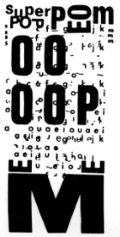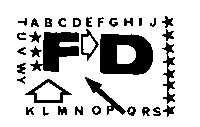François Dufrêne
 François Dufrêne (1930-1982) became involved with Isidore Isou's
Lettrism movement in the early fifties while he was
still in his teens. He broke with Isou's ideas of chiseling language down to a
universal 'alphabet' of preliterate sounds which could be depicted as visual
signs on a page, and expanded the technique as an ultra-lettrisme which
went beneath the page to the sources of human emotion itself. Along with
Jean-Louis Brau and Gil J. Wolman, who were working in a similar vein,
Dufrêne was one of the first to use a microphone to highly amplify minute
acoustical aspects of his voice.
François Dufrêne (1930-1982) became involved with Isidore Isou's
Lettrism movement in the early fifties while he was
still in his teens. He broke with Isou's ideas of chiseling language down to a
universal 'alphabet' of preliterate sounds which could be depicted as visual
signs on a page, and expanded the technique as an ultra-lettrisme which
went beneath the page to the sources of human emotion itself. Along with
Jean-Louis Brau and Gil J. Wolman, who were working in a similar vein,
Dufrêne was one of the first to use a microphone to highly amplify minute
acoustical aspects of his voice.
He created a form of electro-acoustic extended vocal
technique in 1953 which he described as crirythme which had no 'score'
and existed for recording tape alone. The crirythme explored the voice
as a noise source revealing the nonabstracted essence of things much in the
tradition of Antonin Artaud's Pour en finir avec le Jugement de Dieu,
the brutist orchestras of Dada, and Luigi Russolo's
l'arte de rumori. Dufrêne also performed highly rhythmical
semantic works for which there are poem scores, and which followed a French
rhetorical tradition which dated back to the 15th century. He did visual art as
well in a style which was an extension of his early involvement in
Lettrism.
Dufrêne also performed highly rhythmical
semantic works for which there are poem scores, and which followed a French
rhetorical tradition which dated back to the 15th century. He did visual art as
well in a style which was an extension of his early involvement in
Lettrism.
Dufrêne was a very seminal and prolific sound poet,
but unfortunately, his work has long been out of print and unavailable to an
English-speaking except for a few items on republished anthologies.

Last Modified 20 January 1998
 François Dufrêne (1930-1982) became involved with Isidore Isou's
Lettrism movement in the early fifties while he was
still in his teens. He broke with Isou's ideas of chiseling language down to a
universal 'alphabet' of preliterate sounds which could be depicted as visual
signs on a page, and expanded the technique as an ultra-lettrisme which
went beneath the page to the sources of human emotion itself. Along with
Jean-Louis Brau and Gil J. Wolman, who were working in a similar vein,
Dufrêne was one of the first to use a microphone to highly amplify minute
acoustical aspects of his voice.
François Dufrêne (1930-1982) became involved with Isidore Isou's
Lettrism movement in the early fifties while he was
still in his teens. He broke with Isou's ideas of chiseling language down to a
universal 'alphabet' of preliterate sounds which could be depicted as visual
signs on a page, and expanded the technique as an ultra-lettrisme which
went beneath the page to the sources of human emotion itself. Along with
Jean-Louis Brau and Gil J. Wolman, who were working in a similar vein,
Dufrêne was one of the first to use a microphone to highly amplify minute
acoustical aspects of his voice.  Dufrêne also performed highly rhythmical
semantic works for which there are poem scores, and which followed a French
rhetorical tradition which dated back to the 15th century. He did visual art as
well in a style which was an extension of his early involvement in
Lettrism.
Dufrêne also performed highly rhythmical
semantic works for which there are poem scores, and which followed a French
rhetorical tradition which dated back to the 15th century. He did visual art as
well in a style which was an extension of his early involvement in
Lettrism.